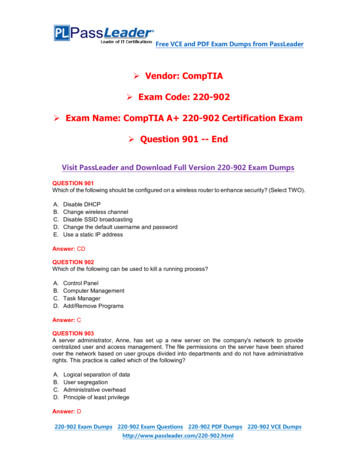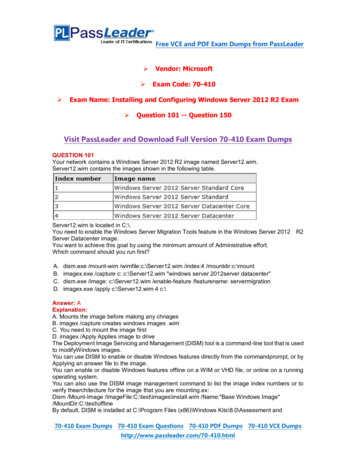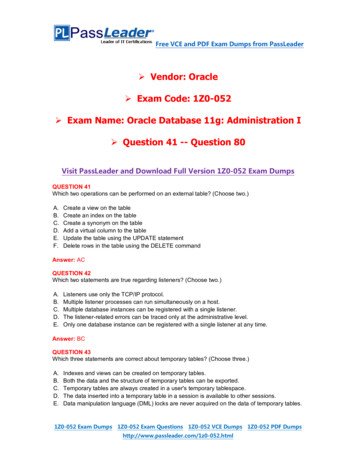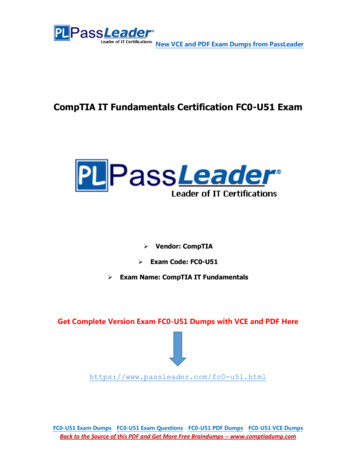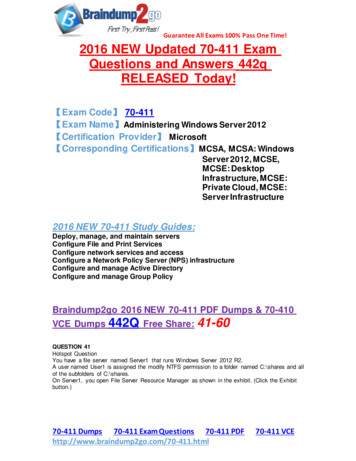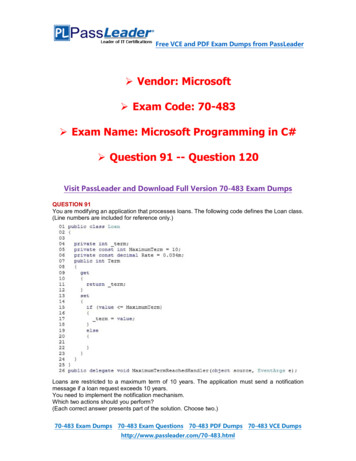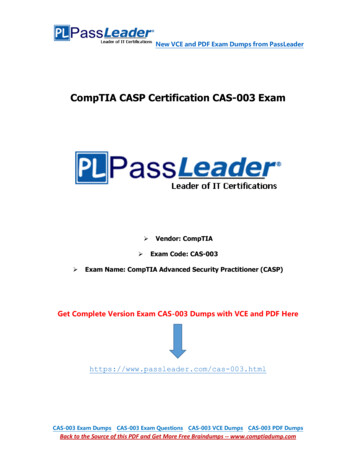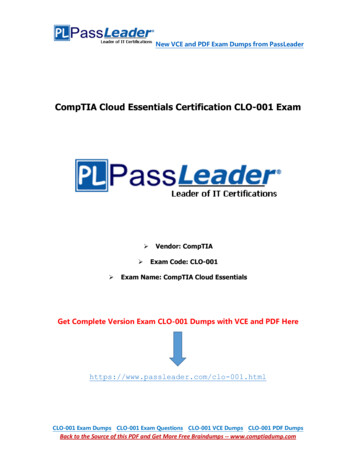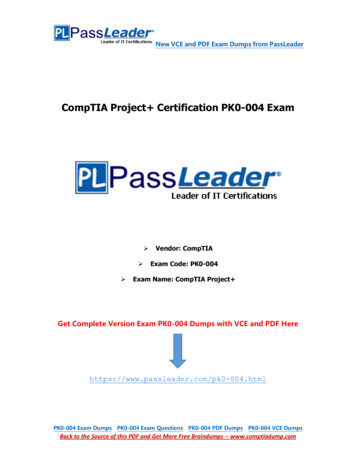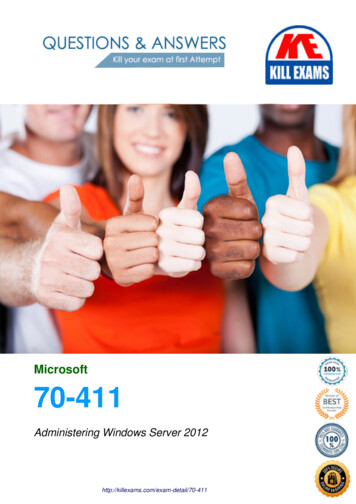
Transcription
Microsoft70-411Administering Windows Server 2012http://killexams.com/exam-detail/70-411
Answer: AExplanation:Priority. Priority specifies the order of importance of the RADIUS server to the NPS proxyserver. Priority level must be assigned a value that is an integer, such as 1, 2, or 3. The lowerthe number, the higher priority the NPS proxy gives to the RADIUS server. For example, ifthe RADIUS server is assigned the highest priority of 1, the NPS proxy sends connectionrequests to the RADIUS server first; if servers with priority 1 are not available, NPS thensends connection requests to RADIUS servers with priority 2, and so on. You can assign thesame priority to multiple RADIUS servers, and then use the Weight setting to load balancebetween them.QUESTION: 101Your network contains an Active Directory domain named adatum.com. The domaincontains a server named Server1 that runs Windows Server 2012 R2. Server1 is configuredas a Network Policy Server (NPS) server and as a DHCP server. The network contains twosubnets named Subnet1 and Subnet2. Server1 has a DHCP scope for each subnet. You needto ensure that noncompliant computers on Subnet1 receive different network policies thannoncompliant computers on Subnet2. Which two settings should you configure? (Eachcorrect answer presents part of the solution. Choose two.)A. The NAP-Capable Computers conditionsB. The NAS Port Type constraintsC. The Health Policies conditionsD. The MS-Service Class conditionsE. The Called Station ID constraintsAnswer: C, DExplanation:The NAP health policy server uses the NPS role service with configured health policies andsystem health validators (SHVs) to evaluate client health based on administrator-definedrequirements. Based on results of this evaluation, NPS instructs the DHCP server to providefull access to compliant NAP client computers and to restrict access to client computers thatare noncompliant with health requirements. If policies are filtered by DHCP scope, then MSService Class is configured in policy conditions.QUESTION: 102Your network is configured as shown in the exhibit. (Click the Exhibit button.)134
Server1 regularly accesses Server2. You discover that all of the connections from Server1 toServer2 are routed through Router1. You need to optimize the connection path from Server1to Server2. Which route command should you run on Server1?A. Route add -p 10.10.10.0 MASK 255.255.255.0 172.23.16.2 METRIC 100B. Route add -p 10.10.10.0 MASK 255.255.255.0 10.10.10.1 METRIC 50C. Route add -p 10.10.10.12 MASK 255.255.255.0 10.10.10.1 METRIC 100D. Route add -p 10.10.10.12 MASK 255.255.255.0 10.10.10.0 METRIC 50Answer: AExplanation:Destination - specifies either an IP address or host name for the network or host.subnetmask - specifies a subnet mask to be associated with this route entry. If subnetmask isnot specified, 255.255.255.255 is used.gateway - specifies either an IP address or host name for the gateway or router to use whenforwarding.costmetric - assigns an integer cost metric (ranging from 1 through 9,999) to be used incalculating the fastest, most reliable, and/or least expensive routes. If costmetric is notspecified, 1 is used.interface - specifies the interface to be used for the route that uses the interface number. If aninterface is not specified, the interface to be used for the route is determined from thegateway IP address.References:http: //support. microsoft. com/kb/299540/en-ushttp: //technet. microsoft. com/en-us/library/cc757323%28v ws. 10%29. aspxQUESTION: 103Your network contains an Active Directory domain named contoso.com. The domaincontains a RADIUS server named Server1 that runs Windows Server 2012 R2. You add aVPN server named Server2 to the network. On Server1, you create several network policies.You need to configure Server1 to accept authentication requests from Server2. Which toolshould you use on Server1?A. Server Manager135
B. Routing and Remote AccessC. New-NpsRadiusClientD. Connection Manager Administration Kit (CMAK)Answer: CExplanation:New-NpsRadiusClient -Name "NameOfMyClientGroup" -Address "10.1.0.0/16" AuthAttributeRequired 0 -NapCompatible 0 -SharedSecret "SuperSharedSecretxyz" VendorName "RADIUS Standard"136
Reference:http: //technet. microsoft. com/en-us/library/hh918425(v wps. 620). aspxhttp: //technet. microsoft. com/en-us/library/jj872740(v wps. 620). aspxhttp: //technet. microsoft. com/en-us/library/dd469790. AspxQUESTION: 104Your network contains an Active Directory domain named contoso.com. The domaincontains a domain controller named DC1 that runs Windows Server 2012 R2. All clientcomputers run Windows 8 Enterprise. DC1 contains a Group Policy object (GPO) namedGPO1. You need to update the PATH variable on all of the client computers. Which GroupPolicy preference should you configure?137
A. Ini FilesB. ServicesC. Data SourcesD. EnvironmentAnswer: DExplanation:Environment Variable preference items allow you to create, update, replace, and delete userand system environment variables or semicolon-delimited segments of the PATH variable.Before you create an Environment Variable preference item, you should review the behaviorof each type of action possible with this extension.QUESTION: 105Your network contains an Active Directory domain named contoso.com. All domaincontrollers run Windows Server 2012 R2. An organizational unit (OU) named OU1 contains200 client computers that run Windows 8 Enterprise. A Group Policy object (GPO) namedGPO1 is linked to OU1. You make a change to GPO1. You need to force all of the computersin OU1 to refresh their Group Policy settings immediately. The solution must minimizeadministrative effort. Which tool should you use?A. The Secedit commandB. Group Policy Management Console (GPMC)C. Server ManagerD. The Gpupdate commandAnswer: BExplanation:In the previous versions of Windows, this was accomplished by having the user runGPUpdate.exe on their computer.Starting with Windows Server 2012 and Windows 8, you can now remotely refreshGroup Policy settings for all computers in an OU from one central location through theGroup Policy Management Console (GPMC). Or you can use the Invoke-GPUpdatecmdlet torefresh Group Policy for a set of computers, not limited to the OU structure, for example, ifthe computers are located in the default computers container.138
139
http: //technet. microsoft. com/en-us//library/jj134201. aspxhttp: //blogs. technet. in-windowsserver-2012-using-remote-gpupdate. aspxQUESTION: 106HOTSPOTYour network contains 25 Web servers that run Windows Server 2012 R2. You need toconfigure auditing policies that meet the following requirements: Generate an event each time a new process is created. Generate an event each time a user attempts to access a file share.Which two auditing policies should you configure? To answer, select the appropriate twoauditing policies in the answer area.140
Answer:QUESTION: 107141
HOTSPOTYour network contains an Active Directory domain named contoso.com. The domaincontains a server named Server1 that runs Windows Server 2012 R2 and has the NetworkPolicy Server role service installed. An administrator creates a Network Policy Server (NPS)network policy named Policy1. You need to ensure that Policy1 applies to L2TP connectionsonly. Which condition should you modify? To answer, select the appropriate object in theanswer area.Answer:142
QUESTION: 108Your network contains an Active Directory domain named contoso.com. All domaincontrollers run Windows Server 2012 R2. On all of the domain controllers, Windows isinstalled in C:\Windows and the Active Directory database is located in D:\Windows\NTDS\.All of the domain controllers have a third-party application installed. The operating systemfails to recognize that the application is compatible with domain controller cloning. Youverify with the application vendor that the application supports domain controller cloning.You need to prepare a domain controller for cloning. What should you do?A. In D:\Windows\NTDS\, create an XML file named DCCloneConfig.xml and add theapplication information to the file.B. In the root of a USB flash drive, add the application information to an XML file namedDefaultDCCIoneAllowList.xml.C. In D:\Windows\NTDS\, create an XML file named CustomDCCloneAllowList.xml andadd the application information to the file.D. In C:\Windows\System32\Sysprep\Actionfiles\, add the application information to anXML file named Respecialize.xml.Answer: CExplanation:Place the CustomDCCloneAllowList.xml file in the same folder as the Active Directory143
database (ntds. dit) on the source Domain Controller.References:http: //blogs. dirteam. ows-server-2012-part-13-domain-controllercloning. aspxhttp: //www. thomasmaurer. e-avirtual-domain-controllerhttp: //technet. microsoft. com/en-us/library/hh831734. aspxQUESTION: 109Your network contains an Active Directory domain named contoso.com. All domaincontrollers run Windows Server 2012 R2. An organizational unit (OU) named OU1 contains200 client computers that run Windows 8 Enterprise. A Group Policy object (GPO) namedGPO1 is linked to OU1. You make a change to GPO1. You need to force all of the computersin OU1 to refresh their Group Policy settings immediately. The solution must minimizeadministrative effort. Which tool should you use?A. Server ManagerB. Active Directory Users and ComputersC. The Gpupdate commandD. Group Policy Management Console (GPMC)Answer: DExplanation:Starting with Windows Server 2012 and Windows 8, you can now remotely refreshGroup Policy settings for all computers in an OU from one central location through theGroup Policy Management Console (GPMC). Or you can use the Invoke-GPUpdatecmdlet torefresh Group Policy for a set of computers, not limited to the OU structure, for example, ifthe computers are located in the default computers container.144
145
References:http: //technet. microsoft. com/en-us//library/jj134201. aspxhttp: //blogs. technet. in-windowsserver-2012-using-remote-gpupdate. aspxQUESTION: 110Your network contains an Active Directory domain named contoso.com. All domaincontrollers run Windows Server 2012 R2. You plan to use fine-grained password policies tocustomize the password policy settings ofcontoso.com. You need to identify to which ActiveDirectory object types you can directly apply the fine- grained password policies. Which twoobject types should you identify? (Each correct answer presents part of the solution. Choosetwo.)A. UsersB. Global groupsC. computersD. Universal groupsE. Domain local groupsAnswer: A, BExplanation:146
First off, your domain functional level must be at Windows Server 2008. Second, Finegrained password policies ONLY apply to user objects, and global security groups. Linkingthem to universal or domain local groups is ineffective. I know what you’re thinking, whatabout OU’s? Nope, Fine-grained password policy cannot be applied to an organizational unit(OU) directly. The third thing to keep in mind is, by default only members of the DomainAdmins group can set fine-grained password policies. However, you can delegate this abilityto other users if needed.Fine-grained password policies apply only to user objects (or inetOrgPerson objects if theyare used instead of user objects) and global security groups.You can apply Password Settings objects (PSOs) to users or global security groups:References:http: //technet. microsoft. com/en-us/library/cc731589%28v ws. 10%29. aspxhttp: //technet. microsoft. com/en-us/library/cc731589%28v ws. 10%29. aspxhttp: //technet. microsoft. com/en-us/library/cc770848%28v ws. 10%29. aspxhttp: //www. brandonlawson. d-policies/QUESTION: 111Your network contains an Active Directory domain named contoso.com. The domaincontains a server named Server1 that runs Windows Server 2012 R2. You enable andconfigure Routing and Remote Access (RRAS) on Server1. You create a user account namedUser1. You need to ensure that User1 can establish VPN connections to Server1. Whatshould you do?A. Create a network policy.B. Create a connection request policy.C. Add a RADIUS client.D. Modify the members of the Remote Management Users group.Answer: AExplanation:Network policies are sets of conditions, constraints, and settings that allow you to designatewho is authorized to connect to the network and the circumstances under which they can orcannot connect.Network policies can be viewed as rules. Each rule has a set of conditions and settings.Configure your VPN server to use Network Access Protection (NAP) to enforce healthrequirement policies.147
References:http: //technet. microsoft. com/en-us/library/hh831683. aspxhttp: //technet. microsoft. com/en-us/library/cc754107. aspxhttp: //technet. microsoft. com/en-us/library/dd314165%28v ws. 10%29. aspxhttp: //technet. microsoft. com/en-us/windowsserver/dd448603. aspxhttp: //technet. microsoft. com/en-us/library/dd314165(v ws. 10). aspxhttp: //technet. microsoft. com/en-us/library/dd469733. aspxhttp: //technet. microsoft. com/en-us/library/dd469660. aspxhttp: //technet. microsoft. com/en-us/library/cc753603. aspxhttp: //technet. microsoft. com/en-us/library/cc754033. aspxhttp: //technet. microsoft. com/en-us/windowsserver/dd448603. AspxQUESTION: 112Your network contains an Active Directory domain named contoso.com. The domaincontains a server named Server1 that runs Windows Server 2012 P.2. Server1 has theNetwork Policy and Access Services server role installed. Your company's security policyrequires that certificate-based authentication must be used by some network services. Youneed to identify which Network Policy Server (NPS) authentication methods comply with thesecurity policy. Which two authentication methods should you identify? (Each correctanswer presents part of the solution. Choose two.)A. MS-CHAPB. PEAP-MS-CHAP v2C. ChapD. EAP-TLSE. MS-CHAP v2Answer: B, DExplanation:PEAP is similar in design to EAP-TTLS, requiring only a server-side PKI certificate to createa secure TLS tunnel to protect user authentication, and uses server-side public keycertificates to authenticate the server.When you use EAP with a strong EAP type, such as TLS with smart cards or TLS withcertificates, both the client and the server use certificates to verify their identities to eachother.QUESTION: 113You have a server named Server1 that runs Windows Server 2012 R2. Server1 has the FileServer Resource Manager role service installed. Each time a user receives an access-deniedmessage after attempting to access a folder on Server1, an email notification is sent to adistribution list named DL1. You create a folder named Folder1 on Server1, and then youconfigure custom NTFS permissions for Folder 1. You need to ensure that when a userreceives an access-denied message while attempting to access Folder1, an email notificationis sent to a distribution list named DL2. The solution must not prevent DL1 from receivingnotifications about other access-denied messages. What should you do?148
A. From File Explorer, modify the Classification tab of Folder1.B. From the File Server Resource Manager console, modify the Email Notifications settings.C. From the File Server Resource Manager console, set a folder management property.D. From File Explorer, modify the Customize tab of Folder1.Answer: CExplanation:When using the email model each of the file shares, you can determine whether accessrequests to each file share will be received by the administrator, a distribution list thatrepresents the file share owners, or both. You can use the File Server Resource Managerconsole to configure the owner distribution list by editing the management properties of theclassification properties.Reference: 2.aspx#BKMK 12QUESTION: 114Your network contains an Active Directory domain named contoso.com. The domaincontains a domain controller named DC1 that runs Windows Server 2012. You have a GroupPolicy object (GPO) named GPO1 that contains several custom Administrative templates.You need to filter the GPO to display only settings that will be removed from the registrywhen the GPO falls out of scope. The solution must only display settings that are eitherenabled or disabled and that have a comment. How should you configure the filter? Toanswer, select the appropriate options below. Select three.149
150
A. Set Managed to: YesB. Set Managed to: NoC. Set Managed to: AnyD. Set Configured to: YesE. Set Configured to: NoF. Set Configured to: AnyG. Set Commented to: YesH. Set Commented to: NoI. Set Commented to: Any151
Answer: A, F, G152
For More exams visit https://killexams.com/vendors-exam-listKill your exam at First Attempt.Guaranteed!
Answer: A Explanation: Priority. Priority specifies the order of importance of the RADIUS server to the NPS proxy server. Priority level must be
